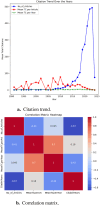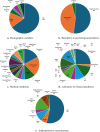Machine learning and artificial intelligence in type 2 diabetes prediction: a comprehensive 33-year bibliometric and literature analysis
- PMID: 40212895
- PMCID: PMC11983615
- DOI: 10.3389/fdgth.2025.1557467
Machine learning and artificial intelligence in type 2 diabetes prediction: a comprehensive 33-year bibliometric and literature analysis
Abstract
Background: Type 2 Diabetes Mellitus (T2DM) remains a critical global health challenge, necessitating robust predictive models to enable early detection and personalized interventions. This study presents a comprehensive bibliometric and systematic review of 33 years (1991-2024) of research on machine learning (ML) and artificial intelligence (AI) applications in T2DM prediction. It highlights the growing complexity of the field and identifies key trends, methodologies, and research gaps.
Methods: A systematic methodology guided the literature selection process, starting with keyword identification using Term Frequency-Inverse Document Frequency (TF-IDF) and expert input. Based on these refined keywords, literature was systematically selected using PRISMA guidelines, resulting in a dataset of 2,351 articles from Web of Science and Scopus databases. Bibliometric analysis was performed on the entire selected dataset using tools such as VOSviewer and Bibliometrix, enabling thematic clustering, co-citation analysis, and network visualization. To assess the most impactful literature, a dual-criteria methodology combining relevance and impact scores was applied. Articles were qualitatively assessed on their alignment with T2DM prediction using a four-point relevance scale and quantitatively evaluated based on citation metrics normalized within subject, journal, and publication year. Articles scoring above a predefined threshold were selected for detailed review. The selected literature spans four time periods: 1991-2000, 2001-2010, 2011-2020, and 2021-2024.
Results: The bibliometric findings reveal exponential growth in publications since 2010, with the USA and UK leading contributions, followed by emerging players like Singapore and India. Key thematic clusters include foundational ML techniques, epidemiological forecasting, predictive modelling, and clinical applications. Ensemble methods (e.g., Random Forest, Gradient Boosting) and deep learning models (e.g., Convolutional Neural Networks) dominate recent advancements. Literature analysis reveals that, early studies primarily used demographic and clinical variables, while recent efforts integrate genetic, lifestyle, and environmental predictors. Additionally, literature analysis highlights advances in integrating real-world datasets, emerging trends like federated learning, and explainability tools such as SHAP (SHapley Additive exPlanations) and LIME (Local Interpretable Model-agnostic Explanations).
Conclusion: Future work should address gaps in generalizability, interdisciplinary T2DM prediction research, and psychosocial integration, while also focusing on clinically actionable solutions and real-world applicability to combat the growing diabetes epidemic effectively.
Keywords: artificial intelligence (AI); bibliometric analysis; machine learning (ML); predictive models; type 2 diabetes mellitus (T2DM).
© 2025 Kiran, Xie, Anjum, Ball, Pierscionek and Russell.
Conflict of interest statement
The authors declare that the research was conducted in the absence of any commercial or financial relationships that could be construed as a potential conflict of interest. The authors declared that they were an editorial board member of Frontiers, at the time of submission. This had no impact on the peer review process and the final decision.
Figures






Similar articles
-
The published role of artificial intelligence in drug discovery and development: a bibliometric and social network analysis from 1990 to 2023.J Cheminform. 2025 May 8;17(1):71. doi: 10.1186/s13321-025-00988-4. J Cheminform. 2025. PMID: 40341055 Free PMC article.
-
Research Trends in the Application of Artificial Intelligence in Oncology: A Bibliometric and Network Visualization Study.Front Biosci (Landmark Ed). 2022 Aug 31;27(9):254. doi: 10.31083/j.fbl2709254. Front Biosci (Landmark Ed). 2022. PMID: 36224012
-
Evolutionary patterns and research frontiers of artificial intelligence in age-related macular degeneration: a bibliometric analysis.Quant Imaging Med Surg. 2025 Jan 2;15(1):813-830. doi: 10.21037/qims-24-1406. Epub 2024 Dec 30. Quant Imaging Med Surg. 2025. PMID: 39839014 Free PMC article.
-
Mapping knowledge landscapes and emerging trends in artificial intelligence for antimicrobial resistance: bibliometric and visualization analysis.Front Med (Lausanne). 2025 Jan 28;12:1492709. doi: 10.3389/fmed.2025.1492709. eCollection 2025. Front Med (Lausanne). 2025. PMID: 39935800 Free PMC article.
-
Precision in Prevention and Health Surveillance: How Artificial Intelligence May Improve the Time of Identification of Health Concerns through Social Media Content Analysis.Yearb Med Inform. 2024 Aug;33(1):158-165. doi: 10.1055/s-0044-1800736. Epub 2025 Apr 8. Yearb Med Inform. 2024. PMID: 40199301 Free PMC article. Review.
References
-
- IDF. Data from: Diabetes facts and figures: IDF diabetes atlas tenth edition 2021 (2021). Available at: https://idf.org/aboutdiabetes/what-is-diabetes/facts-figures.html (Accessed November 23, 2022).
-
- Anderson JP, Parikh JR, Shenfeld DK, Ivanov V, Marks C, Church BW, et al. Reverse engineering and evaluation of prediction models for progression to type 2 diabetes: an application of machine learning using electronic health records. J Diabetes Sci Technol. (2016) 10:6–18. 10.1177/1932296815620200 - DOI - PMC - PubMed
Publication types
LinkOut - more resources
Full Text Sources
Research Materials
Miscellaneous

